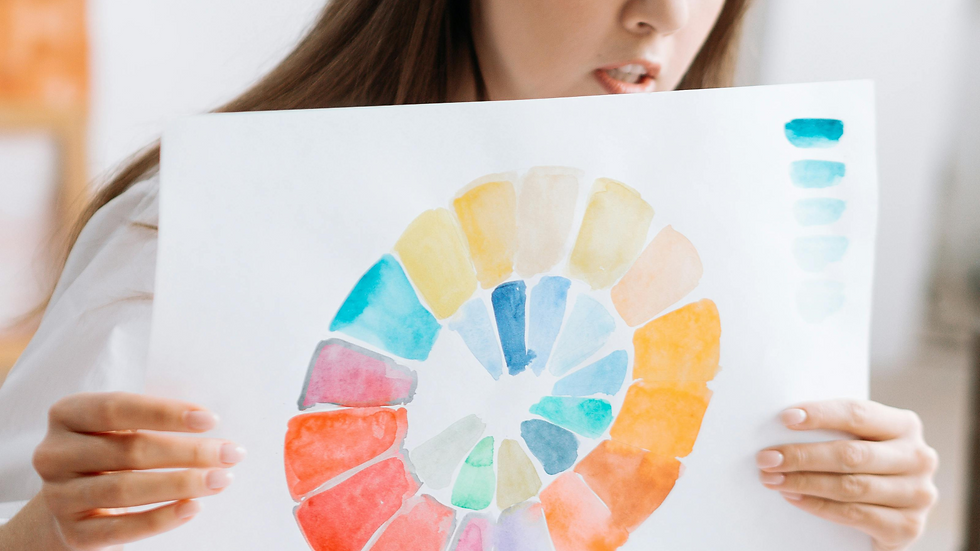The Power of Psychology in Marketing: 4 Principles Every Entrepreneur Should Know to Attract, Engage, and Convert Your Audience (Part 1 of 2; Principles 1 & 2)
- Desiree S.

- Aug 14
- 3 min read

Principle 1: The Role of Color Psychology in Branding: Choosing the Right Palette for Your Business
When you share your story through design, every detail matters—especially color. As an entrepreneur telling a power brand story, you must remember that your brand’s palette doesn’t exist to just be pretty—it’s purposeful.
Color psychology studies how hues influence human perception and behavior. One landmark study found that up to 90% of snap judgments about products are driven by color alone. So choosing wisely isn’t optional, it’s fundamental. Another study published in Management Decision noted that consumers make decisions within 90 seconds of encountering a new product. That means your brand’s colors act like first sentences in a story—setting tone, mood, and reader expectation in a blink.
Color is far more than decoration; it’s a strategic force in brand messaging. When chosen with intention, your palette becomes a visual storyteller, reinforcing values, stirring emotion, and guiding behavior.
Psychology in Marketing: Matching Your Brand Palette to Personality + 4 Practical Steps
The key to aligning color with brand identity is appropriateness. Research shows that consumers respond best when color choices feel congruent with branding values and market positioning.
Blue evokes reliability, stability, and competence—perfect for service‑based or consulting businesses.
Red energizes, sparks passion and urgency—ideal for wellness, creative industries, and social change brands aiming to inspire action.
Green suggests growth, harmony, and eco-consciousness—natural for nature-driven or socially positive ventures.
Orange radiates friendliness, creativity, and vibrancy—making it a standout accent color for bold, warm-hearted brands
Pick your Palette
Define your brand personality Is your approach polished and professional or playful and bold? Map adjectives like “trustworthy,” “innovative,” or “supportive” to emotional color cues. Using a consistent palette helps consumers instantly recognize your brand—helping to increase color recognition
Research your audience Context matters. Personal experiences or cultural backgrounds influence color meaning—so think about how your specific audience interprets your palette.
Shape the emotional tone by selecting a primary color, then add complementary accents: Warm colors energize; cool hues calm—your palette sculpts how people feel when interacting with your brand. Choose one dominant hue that aligns with your core message. Use color theory: find hues opposite on the color wheel to highlight buttons, logos, or calls to action. Contrast = clarity.
Test and iterate Gather feedback via polls, usability tests, or mood boards. Real responses offer proof that your palette supports the intended perception.
Principle 2: The Power of Social Proof in Brand Storytelling
When building a brand that resonates deeply with your audience, color psychology sets the emotional tone—but social proof is what closes the loop of trust. It’s the gentle nudge that transforms curiosity into confidence, and confidence into commitment.
Social proof is a powerful psychological principle rooted in behavioral science: we tend to trust what others trust—especially people who look like us, believe like us, or live like us. Whether it’s a glowing testimonial, a client success story, or a tagged Instagram post, social proof helps reduce doubt and increase connection.
Research supports this—92% of consumers trust user-generated content more than traditional advertising, and 70% say they trust recommendations from people they don’t even know. That means real voices from real people are often more persuasive than even your best marketing message.
At Jali Creatives, we’ve seen this play out across the women-led and mission-driven brands we support. For these brands, social proof is more than just validation—it’s community building. Your audience wants to feel emotionally safe and seen before they commit. Social proof offers that reassurance: “If it worked for her, it might work for me.”
Want to elevate the impact? Combine social proof with color psychology. Use energizing, warm colors like coral or amber around testimonial sections to evoke trust and enthusiasm. Or lean into cooler tones like teal or lavender to offer calm and credibility when sharing transformation stories or data.
When people feel emotionally safe, socially validated, and visually connected—they say yes.
Ready to tell a more trusted, human-centered brand story? Let’s craft your visual narrative and elevate your client voices. Work with Jali Creatives and create branding that builds belief.




Comments